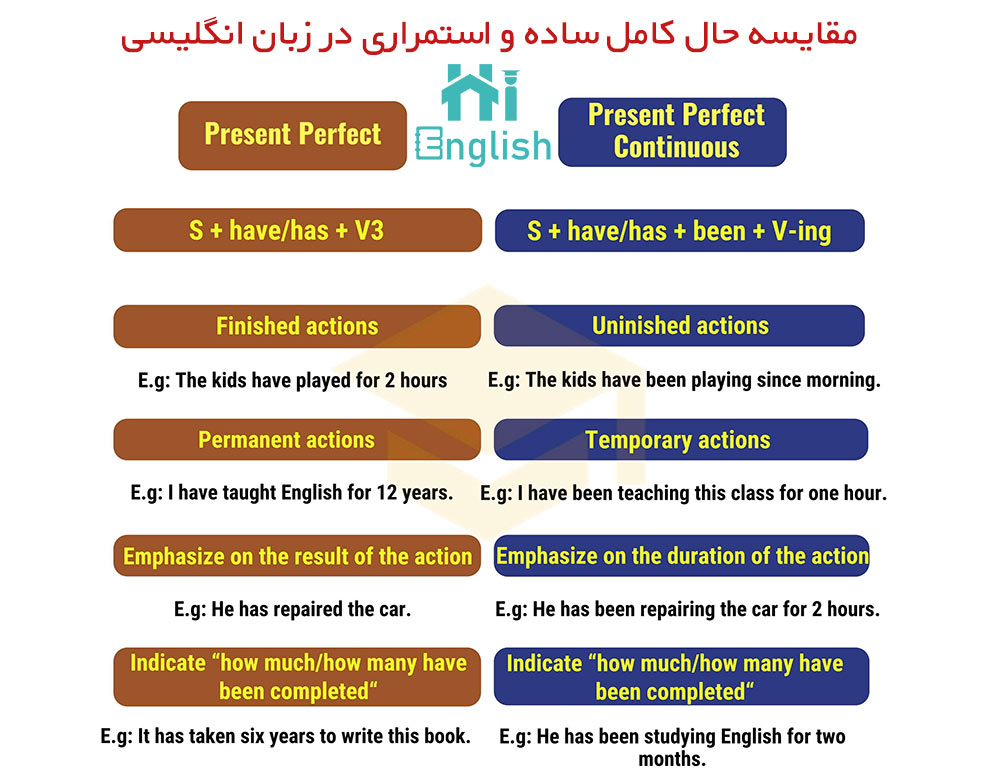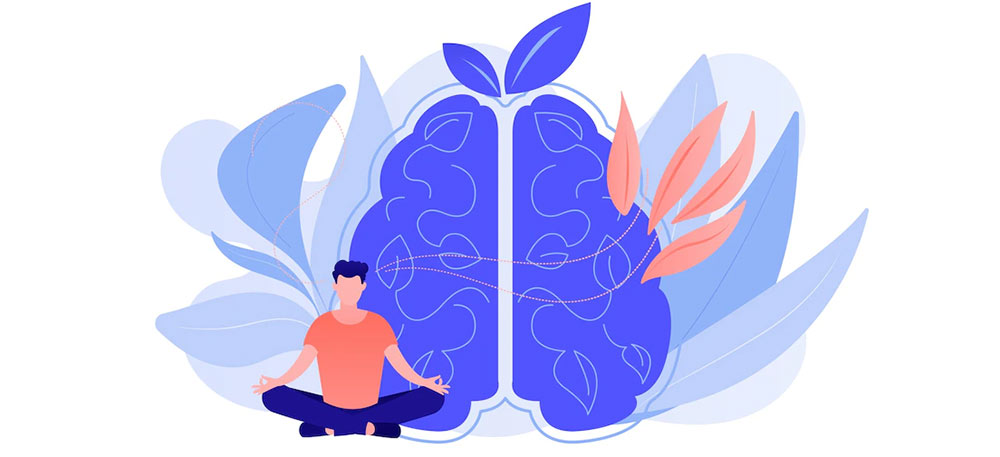حال کامل ساده و استمراری در زبان انگلیسی

در این درس به آموزش حال کامل ساده و استمراری در زبان انگلیسی میپردازیم. تفاوت دو جمله زیر را میدانید؟
We’ve painted the room و We’ve been painting the room
به مثالهای زیر که با present perfect simple و continuous ساخته شدهاند نگاه کنید:
- We’ve painted the bathroom.
- She’s been training for a half-marathon.
- I’ve had three coffees already today!
- They’ve been waiting for hours.
تفاوت حال کامل ساده و استمراری در چیست؟
ما از هر دوی این زمانها یعنی حال کامل ساده و استمراری برای کارهای تمام شده و ناتمام استفاده میکنیم.
حال کامل ساده را میتوان (اغلب با «since» و «for») برای صحبت در مورد اقدامات ناتمام که در گذشته شروع شدهاند و هنوز هم در زمان حال صادق هستند استفاده کرد. اغلب با افعال ثابت استفاده میشود:
- I’ve known John for three years.
حال کامل استمراری نیز میتواند استفاده شود (اغلب با «since» و «for») برای صحبت در مورد اعمال ناتمام که در گذشته شروع شدهاند و هنوز هم در زمان حال صادق هستند. (البته ما از حال کامل استمراری با افعال ثابت استفاده نمیکنیم):
- She’s been living here for three years.
گاهی اوقات واقعاً هیچ تفاوتی در معنای بین دو زمان وجود ندارد. این به ویژه در مورد افعالی مانند “live”، “work” و “study” صادق است:
- They’ve lived in London since 2004.
- They’ve been living in London since 2004.
- I’ve studied French for ten years.
- I’ve been studying French for ten years.
- He’s worked at the company since 2009.
- He’s been working at our company since 2009.
گاهی اوقات در معنی تفاوت وجود دارد:
تاکید بر مدت زمان یا خنثی
1: حال کامل استمراری میتواند برای تأکید بر مدت زمانی که گذشته است استفاده شود. حال کامل ساده به طور کلی خنثی است:
- They’ve been waiting for hours! (This emphasises the length of time).
- They’ve waited for hours. (This doesn’t emphasise the length of time).
مقدار یا تعداد
2: از سوی دیگر، زمانی که ما در مورد مقدار یا تعداد صحبت میکنیم، از حالت فعلی کامل ساده استفاده میشود. این با حال کامل استمراری ممکن نیست:
- She’s drunk three cups of coffee this morning.
- She’s drunk at least a litre of coffee today.
- (NOT:
she’s been drinking three cups of coffee this morning).
تمرکزبر عمل
3: حال کامل استمراری اغلب بر خود عمل متمرکز است، در حالی که حال کامل ساده بر این واقعیت متمرکز است که عمل کامل شده است:
- I’ve been reading the book you recommended. (I’m enjoying it, but I’m not finished).
- I’ve read the book you recommended. (I’ve finished it, so we can talk about it).
ما از «yet» و «already» با حالت ساده فعلی استفاده می کنیم:
- Have you read the book yet?
- She’s finished her work already.
این تفاوت اغلب برای صحبت در مورد انواع مختلف نتایج در حال حاضر استفاده میشود. حال کامل ساده زمانی استفاده میشود که عمل به پایان برسد؛ و نتیجه از پایان عمل حاصل میشود:
- I’ve eaten dinner, so let’s go out.
- She’s done all her homework, so she can relax this evening.
- I’ve made a cake. Would you like some?
زمان حال کامل استمراری زمانی استفاده میشود که نتیجه از خود عمل حاصل شود. فرقی نمیکند که کل عمل تمام شده باشد یا نه. نتیجه اغلب چیزی است که میتوانیم ببینیم، بشنویم، بو کنیم یا احساس کنیم:
- I’ve been eating dinner, so there are plates all over the table.
- She’s been doing her homework, so she’s tired.
- I’ve been making a cake, that’s why the kitchen is such a mess.
تاکید بر موقتی بودن
4: در نهایت، حال کامل استمراری میتواند برای تأکید بر موقتی بودن چیزی استفاده شود:
- She’s been running a lot recently. (She doesn’t usually do this).
- Usually I study at home, but I’ve been studying in the library for the last week.
توضیحات گرامر

از هر دو حالت present perfect simple (have or has + past participle) و present perfect continuous (have or has + been + -ing form) در مورد عملی که از گذشته شروع شده است و تا زمان حال ادامه پیدا کرده است استفاده میکنیم.
Focusing on result or activity
 present perfect simple معمولاً به نوعی بر نتیجه فعالیت تمرکز میکند و present perfect continuous به نوعی بر خود فعالیت تمرکز دارد.
present perfect simple معمولاً به نوعی بر نتیجه فعالیت تمرکز میکند و present perfect continuous به نوعی بر خود فعالیت تمرکز دارد.
| Present perfect simple | Present perfect continuous |
| Focuses on the result | Focuses on the activity |
| You’ve cleaned the bathroom! It looks lovely! | I’ve been gardening. It’s so nice out there. |
| Says ‘how many’ | Says ‘how long’ |
| She’s read ten books this summer. | She’s been reading that book all day. |
| Describes a completed action | Describes an activity which may continue |
| I’ve written you an email. | I’ve been writing emails. |
| When we can see evidence of recent activity | |
| The grass looks wet. Has it been raining? I know, I’m really red. I’ve been running! |
Ongoing states and actions
اغلب از for, since و how long به همراه present perfect simple برای بیان طول مدت رخ دادن عملی استفاده میکنیم.
- How long have you known each other?
- We’ve known each other since we were at school.
اغلب از for, since و how long به همراه present perfect continuous برای صحبت کردن در مورد اقدامات مداوم یا مکرر استفاده میشود.
- How long have they been playing tennis?
- They’ve been playing tennis for an hour.
- They’ve been playing tennis every Sunday for years.
بعضی اوقات present perfect continuous میتواند به یک موقعیت موقتی تاکید کند.
I usually go to the gym on the High Street, but it’s closed for repairs at the moment so I’ve been going to the one in the shopping centre.
خلاصه نکات گرامری درباره حال کامل ساده و استمراری در زبان انگلیسی
- حال کامل ساده برای اعمالی به کار میرود که در گذشته شروع شدهاند و تا حال ادامه دارند.

- حال کامل استمراری برای اعمالی به کار میرود که در گذشته شروع شدهاند و تا حال در حال ادامه دارند.
- فرمول ساخت حال کامل ساده به شکل زیر است: فعل to have + شکل سوم فعل اصلی.
- فعل to have در حال کامل ساده همواره به فرمی با توجه به فاعل استفاده میشود: have برای فاعلهای مفرد و they/you/we/ I have برای فاعلهای جمع.
- فرمول ساخت حال کامل استمراری به شکل زیر است: فعل to have + been + فعل با ing.
- برای ساخت جمله منفی حال کامل ساده از عبارت haven’t / hasn’t + شکل سوم فعل استفاده میشود.
- برای ساخت جمله منفی حال کامل استمراری از عبارت haven’t / hasn’t + been + فعل با ing استفاده میشود.
- در حال کامل ساده، شکل سوم فعل برای بسیاری از افعال به صورت منظم با اضافه کردن -ed به شکل اصلی فعل ساخته میشود، اما برخی از افعال به صورت نامنظم هستند و باید حفظ شوند.
- برای استفاده در حال کامل استمراری، باید فعل با ing را بسازید، که برای بسیاری از افعال به اضافه کردن -ing به شکل اصلی فعل ساخته میشود.
- در حال کامل استمراری هم مانند حال کامل ساده، فعل to have همیشه با توجه به فاعل فرمول مخصوص به خود را دارد.

نمونه سوالات حال کامل ساده و استمراری در زبان انگلیسی
-
Which sentence is in the present perfect simple tense?
a) They have been playing tennis for two hours.
b) She has eaten breakfast already.
c) The dog was barking all night.
d) We will visit the museum tomorrow.
Answer: b) She has eaten breakfast already.
-
Which sentence is in the present perfect continuous tense?
a) He has written four books.
b) They have traveled to many countries.
c) I have been studying for three hours.
d) She has painted a beautiful picture.
Answer: c) I have been studying for three hours.
-
Which of the following is the present perfect simple form of “I have been reading”?
a) I have read
b) I have been read
c) I had read
d) I am reading
Answer: a) I have read
-
Which of the following sentences is in the present perfect continuous tense?
a) They have lived in London for five years.
b) She has baked a cake for the party.
c) I have been jogging every morning this week.
d) The train has arrived at the station.
Answer: c) I have been jogging every morning this week.
-
Which of the following is the present perfect continuous form of “He has worked”?
a) He has been working
b) He had been working
c) He has worked
d) He is working
Answer: a) He has been working
-
Which sentence is in the present perfect simple tense?
a) I have been watching TV all night.
b) She has finished her homework.
c) They have been waiting for the bus for an hour.
d) We have visited Paris many times.
Answer: d) We have visited Paris many times.
-
Which of the following is the present perfect simple form of “They have been sleeping”?
a) They have slept
b) They had slept
c) They have been sleep
d) They are sleeping
Answer: a) They have slept
-
Which sentence is in the present perfect continuous tense?
a) He has written five letters this morning.
b) They have known each other for ten years.
c) She has been singing for an hour.
d) The plane has just landed.
Answer: c) She has been singing for an hour.
-
Which of the following is the present perfect continuous form of “She has danced”?
a) She has been dancing
b) She had been dancing
c) She has dance
d) She is dancing
Answer: a) She has been dancing
-
Which sentence is in the present perfect simple tense?
a) We have been playing soccer since 2 PM.
b) He has traveled to many countries.
c) They have been studying for their exams all week.
d) She has cooked dinner already.
Answer: b) He has traveled to many countries.
